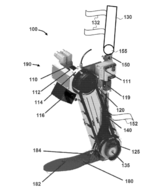Virtual Body-Weight Support via Lower-Limb Exoskeleton
TECHNOLOGY NUMBER: 2021-069
Tags:

OVERVIEW
An orthotic control strategy that provides variable weight augmentation for mobile gait training- A powered lower-limb exoskeleton provides body weight support (BWS) after a neurologic injury
- Permits patients to relearn their natural walking gates while training outside clinical environments
BACKGROUND
Individuals who have sustained a stroke, spinal cord injury, or other neurological condition often struggle to ambulate, and they require gait training to regain mobility and independence. The most common existing methods for providing gait training involve providing the patient body weight support (BWS) during training to help them produce the coordinated muscle activities needed for walking. The conventional technique supplies BWS through a torso or hip harnesses attached to an overhead lift. However, conventional BWS training systems are mounted to a stationary site on the ceiling or treadmill and require significant labor by the clinicians who must move the full weight of patient's limbs. The available powered exoskeletons can help address mobility limitations, though their control systems follow pre-defined joint patterns and discourage patients from actively participating in the training process. Therefore, a need exists for a less restrictive form of BWS through the use of mobile, wearable control systems.
INNOVATION
Researchers have devised a novel control system for powered lower-limb exoskeletons (or orthoses) that provides body-weight support (BWS) for people who have sustained a stroke and other neurological injury. Patients are provided with BWS during conventional gait retraining to help them produce the coordinated muscle activities needed for walking. This control system virtually provides BWS to reduce the gravitational forces experienced by the user's center of mass and lower extremities during locomotion without pre-defined patterns, permitting patients to relearn their natural walking gaits while training outside of clinical environments. Simulation results show that gaits can be augmented in a beneficial way for gait rehabilitation, where patients can start training with easier gaits having higher swing foot clearances to avoid tripping. Though initially created as a rehabilitation tool, this position feedback-based controller could potentially reduce clinicians' workload and lead to a more efficient gait training process. Future invention refinements will include shaping the gravitational constant, which does not appear in the inertia matrix, and exploring experimental implementations.